Document 13310440
advertisement
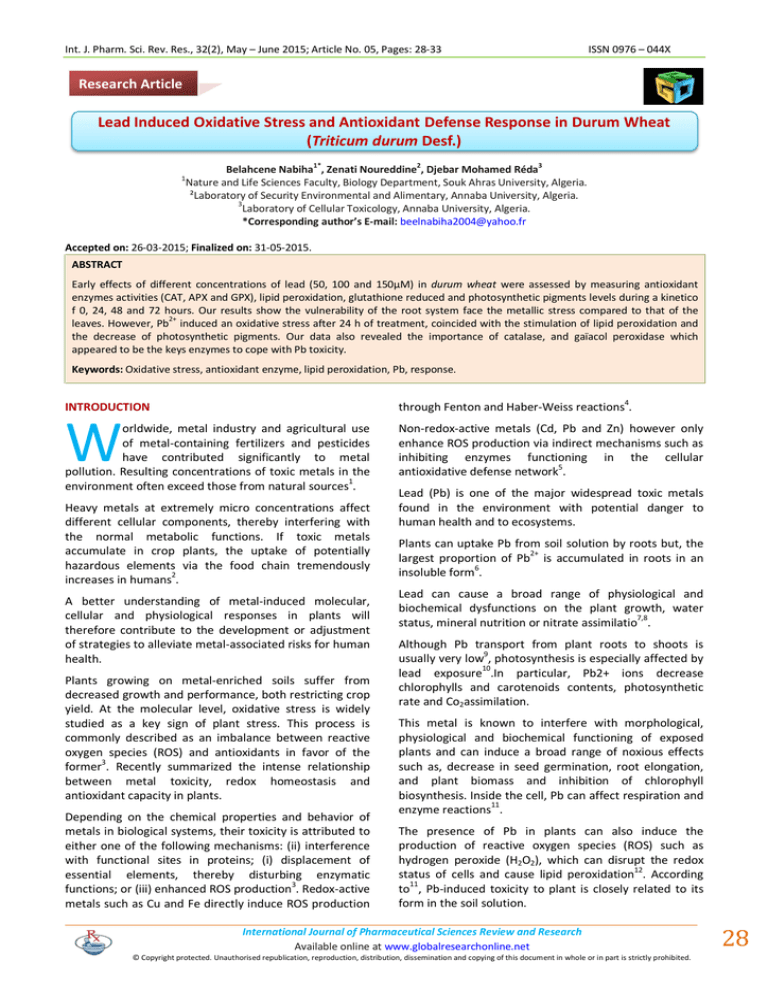
Int. J. Pharm. Sci. Rev. Res., 32(2), May – June 2015; Article No. 05, Pages: 28-33 ISSN 0976 – 044X Research Article Lead Induced Oxidative Stress and Antioxidant Defense Response in Durum Wheat (Triticum durum Desf.) 1* 1 2 3 Belahcene Nabiha , Zenati Noureddine , Djebar Mohamed Réda Nature and Life Sciences Faculty, Biology Department, Souk Ahras University, Algeria. ²Laboratory of Security Environmental and Alimentary, Annaba University, Algeria. 3 Laboratory of Cellular Toxicology, Annaba University, Algeria. *Corresponding author’s E-mail: beelnabiha2004@yahoo.fr Accepted on: 26-03-2015; Finalized on: 31-05-2015. ABSTRACT Early effects of different concentrations of lead (50, 100 and 150µM) in durum wheat were assessed by measuring antioxidant enzymes activities (CAT, APX and GPX), lipid peroxidation, glutathione reduced and photosynthetic pigments levels during a kinetico f 0, 24, 48 and 72 hours. Our results show the vulnerability of the root system face the metallic stress compared to that of the 2+ leaves. However, Pb induced an oxidative stress after 24 h of treatment, coincided with the stimulation of lipid peroxidation and the decrease of photosynthetic pigments. Our data also revealed the importance of catalase, and gaïacol peroxidase which appeared to be the keys enzymes to cope with Pb toxicity. Keywords: Oxidative stress, antioxidant enzyme, lipid peroxidation, Pb, response. INTRODUCTION through Fenton and Haber-Weiss reactions4. W Non-redox-active metals (Cd, Pb and Zn) however only enhance ROS production via indirect mechanisms such as inhibiting enzymes functioning in the cellular antioxidative defense network5. orldwide, metal industry and agricultural use of metal-containing fertilizers and pesticides have contributed significantly to metal pollution. Resulting concentrations of toxic metals in the environment often exceed those from natural sources1. Heavy metals at extremely micro concentrations affect different cellular components, thereby interfering with the normal metabolic functions. If toxic metals accumulate in crop plants, the uptake of potentially hazardous elements via the food chain tremendously increases in humans2. A better understanding of metal-induced molecular, cellular and physiological responses in plants will therefore contribute to the development or adjustment of strategies to alleviate metal-associated risks for human health. Plants growing on metal-enriched soils suffer from decreased growth and performance, both restricting crop yield. At the molecular level, oxidative stress is widely studied as a key sign of plant stress. This process is commonly described as an imbalance between reactive oxygen species (ROS) and antioxidants in favor of the 3 former . Recently summarized the intense relationship between metal toxicity, redox homeostasis and antioxidant capacity in plants. Depending on the chemical properties and behavior of metals in biological systems, their toxicity is attributed to either one of the following mechanisms: (ii) interference with functional sites in proteins; (i) displacement of essential elements, thereby disturbing enzymatic functions; or (iii) enhanced ROS production3. Redox-active metals such as Cu and Fe directly induce ROS production Lead (Pb) is one of the major widespread toxic metals found in the environment with potential danger to human health and to ecosystems. Plants can uptake Pb from soil solution by roots but, the largest proportion of Pb2+ is accumulated in roots in an insoluble form6. Lead can cause a broad range of physiological and biochemical dysfunctions on the plant growth, water status, mineral nutrition or nitrate assimilatio7,8. Although Pb transport from plant roots to shoots is 9 usually very low , photosynthesis is especially affected by 10 lead exposure .In particular, Pb2+ ions decrease chlorophylls and carotenoids contents, photosynthetic rate and Co2assimilation. This metal is known to interfere with morphological, physiological and biochemical functioning of exposed plants and can induce a broad range of noxious effects such as, decrease in seed germination, root elongation, and plant biomass and inhibition of chlorophyll biosynthesis. Inside the cell, Pb can affect respiration and 11 enzyme reactions . The presence of Pb in plants can also induce the production of reactive oxygen species (ROS) such as hydrogen peroxide (H2O2), which can disrupt the redox 12 status of cells and cause lipid peroxidation . According 11 to , Pb-induced toxicity to plant is closely related to its form in the soil solution. International Journal of Pharmaceutical Sciences Review and Research Available online at www.globalresearchonline.net © Copyright protected. Unauthorised republication, reproduction, distribution, dissemination and copying of this document in whole or in part is strictly prohibited. 28 © Copyright pro Int. J. Pharm. Sci. Rev. Res., 32(2), May – June 2015; Article No. 05, Pages: 28-33 To minimize this, cells are equipped with enzymatic and non-enzymatic mechanisms to eliminate or reduce their damaging effects. These protective mechanisms include antioxidant enzymes such as catalase, peroxidase like ascorbate (APX) and guaiacol peroxidase (GPX) and other antioxidant compounds such as glutathione, carotenoids, etc.13 The present study aims to investigate the effects of different concentrations of lead on wheat plants, following exposure after 24, 48 and 72 hoursby studies effects of Pb and lead-induced oxidative stress on photosynthetic pigments and total protein contents, lipid peroxidation and glutathione reduced levels and antioxidant enzymes catalase, ascorbate peroxidase and gaïacol peroxidase. MATERIALS AND METHODS Plant Material and Growth Conditions The uniform seeds of wheat (Triticum durum Desf. cv Cirta) were surface sterilized with 5% NaOCl for 15 min, rinsed with distilled water, imbibed for 24 h in room temperature, and then transferred to the gauze on the tap of plastic aerated pots containing ½ Hoagland nutrient medium (pH 6.2). The plants were grown in a self-regulating culture room and the light/dark period was 16/8 h, temperature 25/20 °C, and relative humidity 75%. They were grown in adapted ‘Hoagland solution’ (Hoagland and Arnon 1950), continuously aerated containing: KNO3 3mM, Ca (NO3)2 1 mM, KH2PO4 2 mM, MgSO4 0.5mM, Fe-Ethylene diamine tetra acetic acid (EDTA) 32.9µM, and micronutrients: H3BO4 30 µM, MnSO4 5 µM, CuSO4 1 µM, ZnSO4 1 µM, and (NH4)6Mo7O 1 µM for 10 days. After growing for 15 days (3-leaf stage), plantlets were subjected to 50, 100 or 150mM PbCl2. After 24, 48 and 72 h of root métallique stress, the shoot samples were collected, washed for 2 min by distilled water, immediately preserved to assay for various biochemical estimations. Chlorophyll Assay Chlorophyll was extracted in 80% acetone. Absorbance was measured at 663 and 645 nm by a spectrophotometer. Extinction coefficients and equations reported by14 were used to calculate the amounts of Chl a, Chl b, Chl a+b and carotenoids. Measurements were done in triplicate. Determination of Lipid Peroxidation Lipid peroxidation was determined by measuring malondialdehyde (MDA), a major thiobarbituric acid reactive species (TBARS), and product of lipid peroxidation15. Samples (0.2 g) are ground in 3 mL of trichloroacetic acid (0.1%, w/v). The homogenate was centrifuged at 10,000 ×g for 10 min and 1 mL of the ISSN 0976 – 044X supernatant fraction was mixed with 4 mL of 0.5% thiobarbituric acid (TBA) in 20% TCA. The mixture was heated at 95°C for 30 min, chilled on ice, and then centrifuged at 10,000 ×g for 5 min. The absorbance of the supernatant was measured at 532 nm. The value for non-specific absorption at 600 nm was subtracted. The amount of MDA was calculated using the extinction coefficient of 155 mM−1 cm−1 and expressed as nmol g−1 FW. Antioxidant Enzymes Activity Analysis Fresh leaves were homogenized in 50 Mm potassium phosphate buffer pH 7.6, the homogenized samples were centrifuged at 12000 ×g for 20 min and the supernatant was used as crude enzyme extract in CAT, APX and GPX16. Catalase (CAT) activity was determined as a decrease in absorbance at 240 nm for 3 min following decomposition of H2O217. The reaction mixture 3 ml contained 50 mM phosphate buffer pH 7.2, 15 mM H2O2 and 100 µl of crude enzyme extract. The activity was calculated using the extinction coefficient 39400 M-1cm-1. Ascorbate peroxidase (APX) activity was determined by following the decrease of ascorbate and measuring the change in absorbance at 290 nm for 3 min in 3 ml of a reaction mixture containing 50 Mm potassium phosphate buffer pH 7.2, 0.5 Mm ascorbic acid, H2O2 and 100 µl of crude enzyme extract18. The activity was calculated using the extinction coefficient 2800M-1cm-1. For Guaïacol peroxidase (GPX) activity, the reaction mixture consisted of 50 mM potassium phosphate, 9 mM guaïacol buffer pH 7.2, 50 µ H2O2 and 100 µl of crude enzyme extract. The enzyme activity was measured by monitoring the increase in absorbance at 470 nm extinction coefficient of 2470 M-1 per cm during polymerization of guaïacol19. RESULTS AND DISCUSSION Lead effects on photosynthetic pigments were presented on Figure 1. Data show that pigment composition was not affected until 48 h. At 72 h, we noted a significant reduction in total chlorophyll (Figure 1c), which reached 28% after treatment with 150 mM of lead. This reduction only affects chlorophyll b (Figure 1b) while an insensitivity of chlorophyll a (Figure 1a) was noted. The different Pb concentrations used have no effect on carotenoid content (Figure 1d) during the treatment period. Our study on the effect of Pb on the different photoreceptor pigments showed, in our case, a total chlorophyll reduction after treatment for 72 h. This reduction is more pronounced at high concentrations (100 and 150 mM) of Pb. This reduction only affects chlorophyll b while the chlorophyll a and carotenoids showed no changes in their levels compared to the control. In our case, total chlorophyll shows a decrease at International Journal of Pharmaceutical Sciences Review and Research Available online at www.globalresearchonline.net © Copyright protected. Unauthorised republication, reproduction, distribution, dissemination and copying of this document in whole or in part is strictly prohibited. 29 © Copyright pro Int. J. Pharm. Sci. Rev. Res., 32(2), May – June 2015; Article No. 05, Pages: 28-33 the end of the treatment, it may be due to the low pass of the metal ion to the aerial parts during the first days of treatment. Degradation of chlorophylls is a well-known aspect of 8 lead toxicity . Lead toxicity on photosynthetic pigments is associated to its availability to inhibit their biosynthesis pathways20. However, in our case, according to the dose and period of lead treatment, it is very unlikely that this phenomenon could be due to biosynthesis inhibition. It could be due to the stimulation of chlorophyllase as demonstrated by21. However, pigment contents were inversely correlated with lipid peroxidation. This correlation indicates that Pb action on photosynthetic pigments can be mediated by ROS. Chl b is known to be more sensitive to lead than Chl 22 a . The accumulation of malondialdehyde was followed during the period of treatment with Pb in the roots and leaves of durum wheat. The Figure 2a shows that at leaf level, the amount of MDA showed no changes compared to controls throughout the treatment for the three metal treatment (50, 100 and 150 mM). The root level (Figure 2b), MDA accumulation varies depending on dose and time of treatment. Indeed, concentrations of 50 and 100 mM of Pb are capable to increasing the production of MDA from about 30% compared to the control after 48 hours of treatment, while a concentration of 150 mM this increases production 43 %. For a longer exposure (72 h), membrane lipid peroxidation remains more pronounced in the presence of 100 and 150 mM metal. Indeed, this stimulation was 71% compared to the control in the roots treated with 100 mM and reached 100% for a 150 mM to Pb treatment. The results indicate that Pb is a stress-inducing agent oxidant causing significant disruption of cellular metabolism. We began by determining the level of membrane lipoperoxides mainly represented by malondialdehyde. Our results showed that the Pb causes an accumulation of MDA only in the durum wheat roots treated with 50, 100 and 150 mM of the metal, so that the sheets do not show any change in their MDA content relative to control plants. This may signal onset of oxidative stress at the root of the seedlings. According to these results, many conclusions can be drawn. Lead strongly modulated the antioxidant enzymes. Such an increase or decrease in the activity of these enzymes has been reported with a variety of heavy metals7,5. In leaves, various antioxidant enzymes exhibited different responses during lead exposure. No significant change was observed before 24 h of exposure. ISSN 0976 – 044X The kinetic analysis of the effects of different doses of Pb on the level of catalase activity in durum wheat shows the maintenance of activity equivalent to that of control in the aerial part of the plant (Figure 3a). In the root part, we noted an increase in the activity of this enzyme after 24 h of treatment irrespective of the dose of Pb (Figure 3b). CAT activity increased throughout Pb treatment and reached a maximum value after 48 h of lead treatment (30 % of control). The abundant data available highlights that the antioxidant response depends on plant species, metal concentration and treatment duration. Detoxification of this molecule may be considered by several enzymes: Catalase (CAT) localized in peroxisomes and mitochondria, the guaiacol peroxidase or GPX localized in the cytoplasm and cell walls and enzymes ascorbate glutathione cycle (APX). This cycle is located in several cellular compartments such as chloroplasts, cytosol, peroxisomes and plasma membranes23,24. In durum wheat, Pb has no effect on the activity of leaf catalase. The lack of response of this enzyme in the leaves may be due to a non-involvement of catalase in the response to stress caused by the lead and that the removal of hydrogen peroxide is then made by means of other enzymatic pathways or enzyme no. In the roots, we noted a sensitivity of catalase to stress caused by Pb which is in the form of a stimulation of its activity particularly at 72 h of treatment. In the leaves, we noted an unchanged activity compared to the control of ascorbate peroxidase in 24, 48 and 72 hours of treatment whatever the dose of Pb in the nutrient solution (Figure 4a). In roots decreased 21% compared to the control of the activity of ascorbate peroxidase at 48 h of treatment (Figure 4b). In the leaves, our results showed the non-involvement of the enzyme ascorbate peroxidase in H2O2 detoxification process. Therefore, the absence of catalase activity, guaiacol peroxidase and ascorbate peroxidase in wheat leaves treated with Pb leaves suggest that the amount of hydrogen peroxide measured in the leaves is not sufficient to cause a modification of the antioxidant activities or late response of these enzymes. Peroxidase guaiacol allows the removal of hydrogen peroxide induces the polymerization of guaïacol in tétragaïacol. This enzyme shows an unchanged level of activity compared to the control at the leaf system (Figure 5a). However, at the root portion (Figure 5b), we noted a significant stimulation whatever the dose used in the nutrient solution at 48 and 72 h of treatment. In the leaves of the seedlings, the GPX activity was unchanged during treatment regardless of the dose of the metal. The response of this enzyme differs depending on the plant species25-28. Other metals are able to modify its 29 activity, such as copper and nickel . International Journal of Pharmaceutical Sciences Review and Research Available online at www.globalresearchonline.net © Copyright protected. Unauthorised republication, reproduction, distribution, dissemination and copying of this document in whole or in part is strictly prohibited. 30 © Copyright pro Int. J. Pharm. Sci. Rev. Res., 32(2), May – June 2015; Article No. 05, Pages: 28-33 ISSN 0976 – 044X Figure 1: Effects of different concentration(s) of lead on the content of photoreceptor pigments in leaves of wheat. The average values and the errors standards were determined from 3 individual measurements. Figure 2: Effects of lead on the content of malondialdehyde (MDA) in leaves (a) and roots (b) of wheat. The average values and the errors standards were determined from 3 individual measurements. Figure 3: Effects of different concentrations of lead on the catalase activity in leaves (a) and roots (b) of wheat. The average values and the errors standards were determined from 3 individual measurements. Figure 4: Effects of different concentrations of lead on the ascorbate peroxidase activity in leaves (a) and roots (b)of wheat. The average values and the errors standards were determined from 3 individual measurements. International Journal of Pharmaceutical Sciences Review and Research Available online at www.globalresearchonline.net © Copyright protected. Unauthorised republication, reproduction, distribution, dissemination and copying of this document in whole or in part is strictly prohibited. 31 © Copyright pro Int. J. Pharm. Sci. Rev. Res., 32(2), May – June 2015; Article No. 05, Pages: 28-33 ISSN 0976 – 044X Figure 5: Effects of different concentrations of lead on the guaïacol peroxidase activity in leaves (a) and roots (b) of wheat. The average values and the errors standards were determined from 3 individual measurements. 5. Schützendübel A, Polle A, Plant responses to abiotic stresses: heavy metal-induced oxidative stress and protection by mycorrhization, Exp. Bot, 53, 2002, 1351– 1365. 6. Wierzbicka MH, Przedpełska E, Ruzik R, Ouerdane L, PołećPawlak K, Jarosz M, Szpunar J, Szakiel A, Comparison of the toxicity and distribution of cadmium and lead in plant cells, Protoplasma, 231, 2007, 99-111. On the effect of Pb on the different pigments photoreceptors, the results show a total chlorophyll reduction after 48 h of treatment. 7. Seregin IV, Ivanov VB, Physiological Aspects of Cadmium and Lead Toxic Effects on Higher Plants,Russ. J. Plant Physiology, 48, 2001, 606-630. This reduction is more pronounced at high concentrations (100 and 150 mM) of Pb and only affects chlorophyll b while the chlorophyll a and carotenoids showed no changes in their content compared to the control. 8. Sharma P, Dubey RS, Lead toxicity in plants, Brazilian Journal of Plant Physiology, 17, 2005, 35-52. 9. Huang JW, Cunningham SD, Lead phytoextraction: species variation in lead uptake and translocation, New Phytologist, 134, 1996, 75-84. CONCLUSION In conclusion, our results demonstrate that lead uptake by roots was not linear along first day in wheat plants treated with different concentrations of lead. This result is important because elevations of Pb uptake rate caused an oxidative stress in roots and induced lipid peroxidation. The amount of MDA showed no changes compared to controls throughout the treatment for the three metal treatments (50, 100 and 150 mM). The root level, MDA accumulation varies depending on dose and time of treatment. The kinetic analysis of the effects of different doses of Pb on the level of catalase, ascorbate peroxidase and guaïacol peroxidase activities shows the maintenance of activity equivalent to that of control in the leaves. In the root part, our results also show that catalase and guaïacol peroxidase accumulation was strongly induced in presence of the height concentrations, after 48 h of treatment irrespective of the dose of Pb. REFERENCES 1. 2. Nriagu JO, Pacyna JM, Quantitative assessment of worldwide contamination of air, water and soils by trace metals, Nature, 333, 1988, 134-139. Chary NS, Kamala CT, Raj DSS, Assessing risk of heavy metals from consuming food grown on sewage irrigated soils and food chain transfer, Ecotoxicol. Environ. Saf, 69, 2008, 513-524. 3. Sharma SS, Dietz KJ, The relationship between metal toxicity and cellular redox imbalance, Trends Plant Sci, 14, 2009, 43-50. 4. Halliwell B, Reactive species and antioxidants: redox biology is a fundamental therme of aerobic life, Plant Physiology, 141, 2006, 312-322. 10. Huang CY, Bazzaz FA, Vanderhoef LN, The Inhibition of Soybean Metabolism by Cadmium and Lead, Plant Physiology, 54, 1974, 122-124. 11. Shahid M, Pinelli E, Pourrut B, Silvestre J, Dumat C, Lead induced genotoxicity to Vicia faba L. roots in relation with metal cell uptake and initial speciation, Ecotoxicol Environ Saf, 74, 2011, 78–84. 12. Shahid M, Pinelli P, Dumat C, Review of Pb availability and toxicity to plants in relation with metal speciation; role of synthetic and natural organic ligands, J. Hazard. Mater, 13, 2012, 215-221. 13. Dietz KJ, Baier M, Kramer U, Free radicals and reactive oxygen species as mediators of heavy metal toxicity in plants. In: Prasad MNV, Hagemeyer J (eds.), Heavy metal stress in plants from molecules to ecosystems, SpringerVerlag, Berlin, 1999, 73-98. 14. Lichtenthaler HK, Chlorophylls and carotenoids: pigments of photosynthetic biomembranes, Methods in Enzymology, 148, 1987, 350-382. 15. Heath RL, Packer L, Photoperoxidation in isolated chloroplasts: I. Kinetic and stoichiometry of fatty acid peroxidation, Arch. Biochem. Biophys, 125, 1968, 189-198. 16. Cakmak N, Horst WJ, Effect of aluminum on lipid peroxidation, superoxide dismutase, catalase and peroxidases activities in root tips of soybean, Physiology Plant, 83, 1991, 463-468. 17. Loggini B, Scartazza A, Brugnoli E, Navari-Izzo F, Antioxidative defense system, pigment composition and International Journal of Pharmaceutical Sciences Review and Research Available online at www.globalresearchonline.net © Copyright protected. Unauthorised republication, reproduction, distribution, dissemination and copying of this document in whole or in part is strictly prohibited. 32 © Copyright pro Int. J. Pharm. Sci. Rev. Res., 32(2), May – June 2015; Article No. 05, Pages: 28-33 photosynthetic efficiency in two wheat cultivars subjected to drought, Plant Physiology, 119, 1999, 1091-1099. 18. Nakano Y, Asada K, Hydrogen Peroxide is Scavenged by Ascorbate-specific Peroxidase in Spinach Chloroplasts, Plant Cell and Physiology, 22, 1981, 867-880. 19. Hiner A, Ruiz J, Lopez JN, Arnao MB, Raven EL, Canovas FJ, Acosta M, Kinetic study of the inactivation of Ascorbateperoxidase by hydrogen peroxide, Biochemistry Journal, 348, 2002, 321-328. 20. Łukaszek M, Poskuta J, Development of photosynthetic apparatus and respiration in pea seedlings during greening as influenced by toxic concentration of lead, Acta Physiologiae Plantarum, 20, 1998, 35-40. 21. Drazkiewicz M, Chlorophyll-occurrence, functions, mechanism of action, effects of internal and external factors, Photosynthetica, 30, 1994, 321-331. ISSN 0976 – 044X sativum L.) leaves, Plant Physiology, 114, 1997, 275-284. 24. Noctor G, Foyer CH, Ascorbate and glutathione: Keeping active oxygen under control. Annu Rev. Plant Physiology, 49, 1998, 249-279. 25. M Sandalio L, Dalurzo HC, Gómez M, Romero-Puertas MC, Del Rio N, Cadmium-induced changes in the growth and oxidative metabolism of pea plants, J. Exp.Bot. 52, 2001, 2115-2126. 26. Mishra S, Srivastava S, Tripathi RD, Govindarajan R, Kuriakose SV, Prasad MNV, Phytochelatin synthesis and response of antioxidants during cadmium stress in Bacopa monnieri L, Plant Physiology Biochemistry, 44, 2006, 25-37. 27. Singh S, Eapen SD, Souza SF, Cadmium accumulation and its influence on lipid peroxidation and antioxidative system in an aquatic plant, Bacopa monnieri L, Chemosphere, 62, 2006, 233-246. 22. Wozny A, Schneider J, Gwozdz EA, The effects of lead and kinetin on greening barley leaves, Biologia plantarum, 37, 1995, 541-552. 28. Lin R, Wang W, Luo Y, Du W, Guo H, Yin D, Effects of soil cadmium on growth, oxidative stress and antioxidant system in wheat seedlings (Triticum aestivum L.), Chemosphere, 69, 2007, 89-98. 23. Jiménez A, Hernández JA, Del Rĭo LA, Ros Barcelŏ A, Sevilla F, Evidence for the presence of the ascorbate–glutathione cycle in mitochondria and peroxisomes of pea (Pisum 29. Baccouche S, Chaoui A, El Ferjani E, Nickel induced oxidative damage and antioxidant reponses in Zea mays shoots, Plant Physiol. Biochem, 36, 1998, 689-694. Source of Support: Nil, Conflict of Interest: None. International Journal of Pharmaceutical Sciences Review and Research Available online at www.globalresearchonline.net © Copyright protected. Unauthorised republication, reproduction, distribution, dissemination and copying of this document in whole or in part is strictly prohibited. 33 © Copyright pro
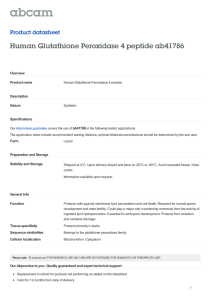

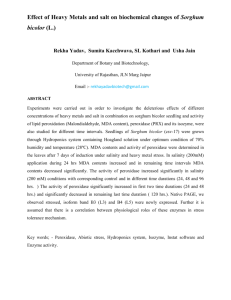
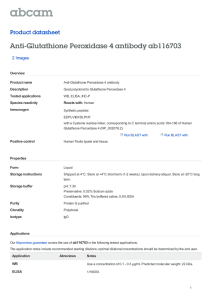
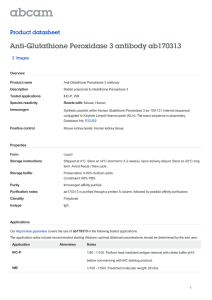
![Anti-Thyroid Peroxidase antibody [1.B.10] ab31829 Product datasheet Overview Product name](http://s2.studylib.net/store/data/011964745_1-5f75fbef9c57765583cc9a2be1b15b4b-300x300.png)